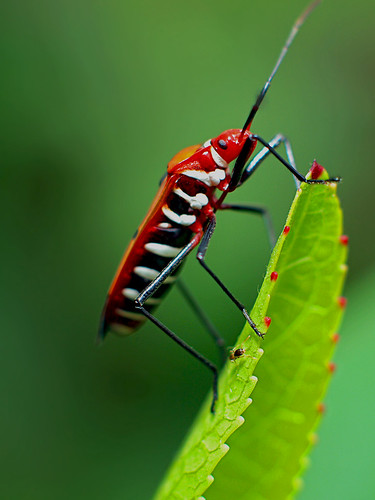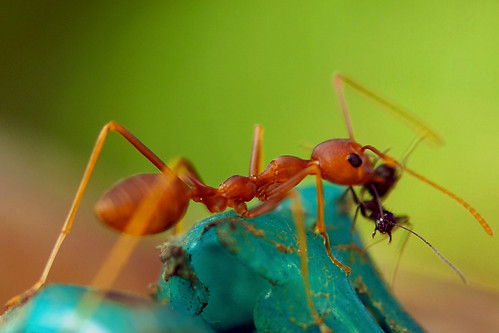ENTOMOgraphy [Insects]
Sunday November 20th 2011 [update]
Among all the insects, ants are quite easy to find and can be shot without difficulty especially in the early morning light.
ZD 35mm f3.5 macro @ f3.5 1/60sec ISO200
Insects are studied because of their importance as pollinators for fruit crops; as carriers of bacterial, viral, and fungal diseases; as parasites of humans or livestock; as destroyers of economically important plants; or as predators of other destructive insects.

ZD 70-300mm f4.0/5.6 @ f11 1/250sec ISO200
Unlike butterflies, insects can be found almost anywhere. I didn't have to ride or drive away from home to find them. Insects can be found flying, crawling or just resting or hiding any time from dawn to dusk.
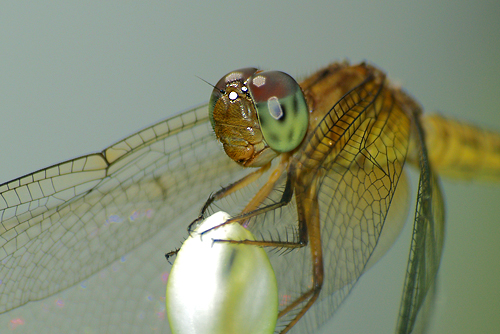
ZD 70-300mm f4.0/5.6 @ f6.7 1/250sec ISO200
Of all the things there are to photograph I find insects the most satisfying and the most difficult. They almost never do what I want them to and are most likely to do whatever I least expect.
Saturday January 12th 2008
It is bright, clear and sunny day. There are lots of fruit trees and bushes behind uncle.D's house. Few species of bird, insect, arachnid could be found there.

This bee is making honey comb and babies under the canopy of a mangostein tree, it stings...
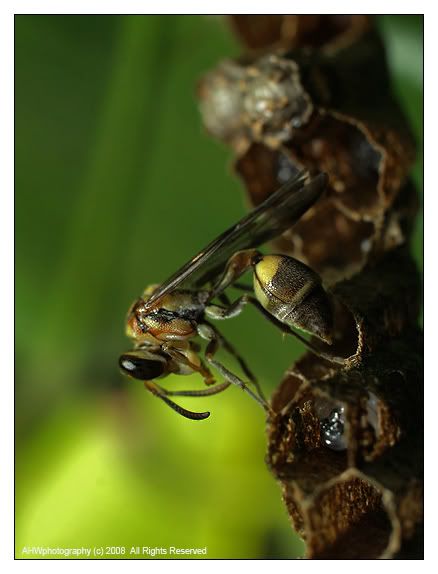
ZD 35mm f3.5 macro @ f11 1/160sec ISO200
This dragonfly was spotted Friday 11th late afternoon on one of the rambutan branches. This insect was shot again on Jan 12th - must be the same dragonfly spotted on previous day.
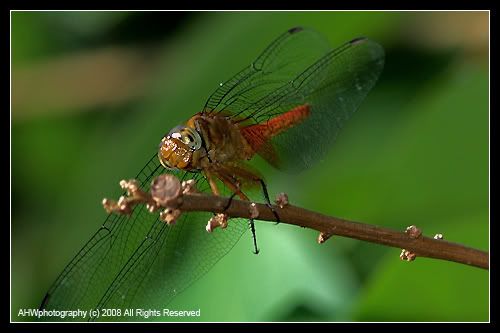
Look at the wing details. They are more complex than the aeroplane wing structures.
Tuesday December 25th 2007
Merry X-mas! to those who celebrate.
After a good lunch I spent time loitering on backyard. Suddenly I spotted this tiny creature making nest, kinda honey comb. By hand held, it was not easy to get focused on 2mm-compound eyes with less than 1mm dof. Finally got one after about a dozen on shots.

ZD 35mm f3.5 macro @ f6.7 1/250sec ISO200
...and another small insect
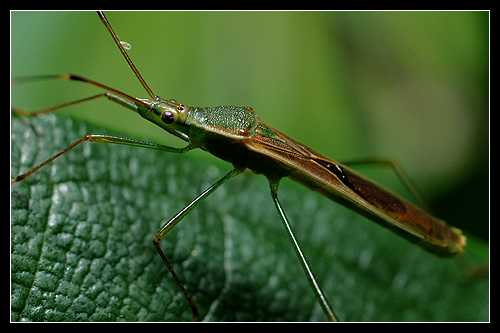
ZD 35mm f3.5 macro @ f10 1/125sec ISO200
ANTs
Facts: There are over 10,000 known species of ants. Ants are clean and tidy insects. Some worker ants are given the job of taking the rubbish from the nest and putting it outside in a special rubbish dump! Each colony of ants has its own smell. In this way, intruders can be recognized immediately. Ants can lift 20 times their own body weight. An ant brain has about 250 000 brain cells. A human brain has 10 billion.
Weaver Ant
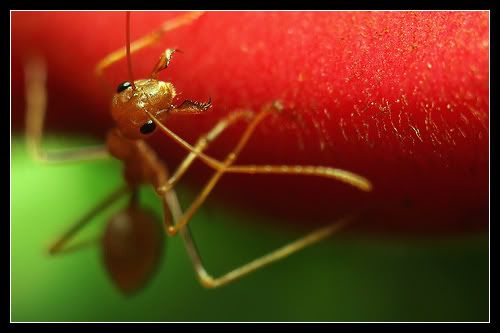
Weaver ants are social insects known for their communication and nest building behavior that have complex bio-chemical communication and make elaborate nests out of living tree-leaves. Weaver ants are found in the tropical forests. They are colored a shade of red and are known for their painful, irritating sting.
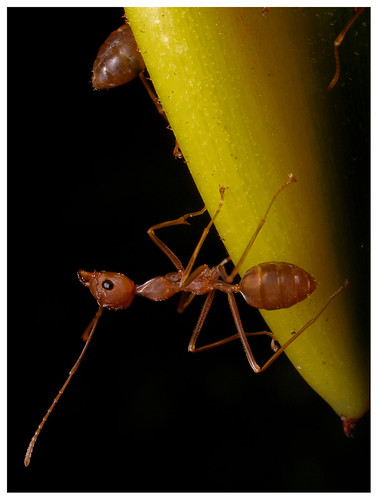

Oly C-5050z @1/1000 f6.3 ISO64 60mm EFL
Normally when there are fruit trees it is very easy to spot this weaver ant. However not many of us aware that this insect has established a smart pasrtnership with other living organisms. The insect give protection to the later while getting some kind of juice in return.
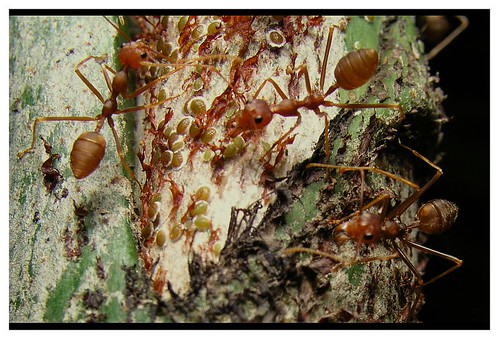
Oly C-5050z @1/1000 f5.6 ISO64 60mm EFL
Another picture showing how the smart-partnership is practiced

Oly C-5050z @1/1000 f5.6 ISO64 60mm EFL
Special posing...but deadly!
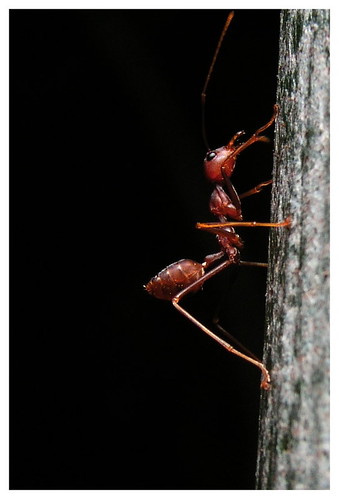
Oly C-5050z @1/1000 f5.6 ISO64 60mm EFL
Weaver ants form the most elaborate communicative organization in the insect world through their simple intelligence. At first the queen ant lays her eggs among tree leaves while the worker ants engage in building the nest. This emergent ant society helps in building the nest by weaving together living tree leaves. This is done by first forming ant chains that hold together leaves and then manipulating the ant larva to produce silk in order to glue the tree leaves. Thus the ant colony emerges with the queen in the center of the nest whose only purpose is to lay eggs while sterile female ants engage in building the nest.
Red Ants
Red Ants or Fire Ants can be easily recognised by their copper brown head and body, with a darker abdomen. Measuring between 2mm to 5mm. The different sizes can be found in a single colony. These are actually workers [sterile females].
A bee "Crash Site" means...
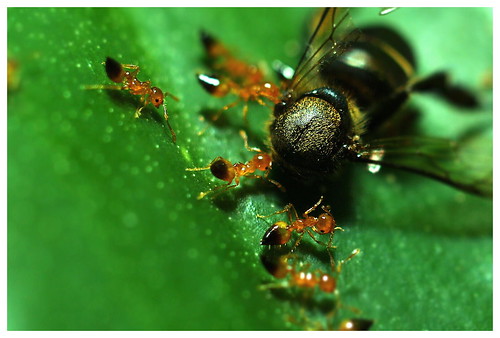
..."Big Feast" for these tiny red ants
The male ant are not workers - only to mate with the queen, once done, the males continue on searching for another queen. A queen is the largest ant in the colony. The queen is for reproduction - live up to 5 years or more, produces up to 1500 eggs per day. There could be many queens in each colony.
The black garden ant (Lasius niger)

ODONATA
Odonata is an order of insects, encompassing dragonflies and damselflies. These insects have large rounded heads, faceted eyes, legs that facilitate catching other insects in flight, two pairs of long, transparent wings that move independently, and elongated abdomens. They are aquatic or semi-aquatic as juveniles. Thus, adults are most often seen near bodies of water and are frequently described as aquatic insects.
Dragonfly
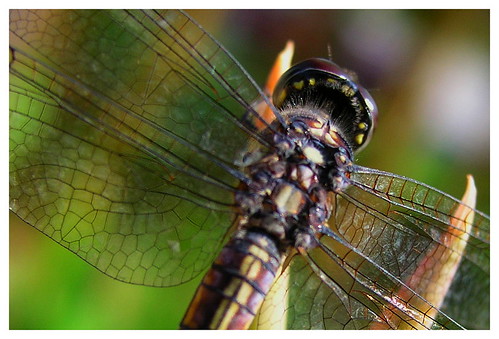

Oly C-5050z @1/500 f2.8 ISO64 60mm EFL
_____________________________________________________
The following insects are considered as....
PESTs
Roach
The night crawler. In existance since dinosour era [i.e during Carboniferous period between 350–300 million years ago]
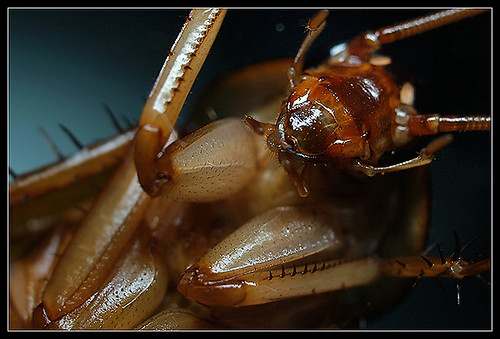
Cockroaches exist everywhere, except in Artic and Antartica. There are more than 3,000 species in six families.
Mosquitos
Need no introduction... but if somebody want to read more about this insect click here.

HOMEpage
Insects are studied because of their importance as pollinators for fruit crops; as carriers of bacterial, viral, and fungal diseases; as parasites of humans or livestock; as destroyers of economically important plants; or as predators of other destructive insects.

ZD 70-300mm f4.0/5.6 @ f11 1/250sec ISO200
Unlike butterflies, insects can be found almost anywhere. I didn't have to ride or drive away from home to find them. Insects can be found flying, crawling or just resting or hiding any time from dawn to dusk.

ZD 70-300mm f4.0/5.6 @ f6.7 1/250sec ISO200
Of all the things there are to photograph I find insects the most satisfying and the most difficult. They almost never do what I want them to and are most likely to do whatever I least expect.
Saturday January 12th 2008
It is bright, clear and sunny day. There are lots of fruit trees and bushes behind uncle.D's house. Few species of bird, insect, arachnid could be found there.

This bee is making honey comb and babies under the canopy of a mangostein tree, it stings...

ZD 35mm f3.5 macro @ f11 1/160sec ISO200
This dragonfly was spotted Friday 11th late afternoon on one of the rambutan branches. This insect was shot again on Jan 12th - must be the same dragonfly spotted on previous day.

Look at the wing details. They are more complex than the aeroplane wing structures.
Tuesday December 25th 2007
Merry X-mas! to those who celebrate.
After a good lunch I spent time loitering on backyard. Suddenly I spotted this tiny creature making nest, kinda honey comb. By hand held, it was not easy to get focused on 2mm-compound eyes with less than 1mm dof. Finally got one after about a dozen on shots.

ZD 35mm f3.5 macro @ f6.7 1/250sec ISO200
...and another small insect

ZD 35mm f3.5 macro @ f10 1/125sec ISO200
ANTs
Facts: There are over 10,000 known species of ants. Ants are clean and tidy insects. Some worker ants are given the job of taking the rubbish from the nest and putting it outside in a special rubbish dump! Each colony of ants has its own smell. In this way, intruders can be recognized immediately. Ants can lift 20 times their own body weight. An ant brain has about 250 000 brain cells. A human brain has 10 billion.
Weaver Ant

Weaver ants are social insects known for their communication and nest building behavior that have complex bio-chemical communication and make elaborate nests out of living tree-leaves. Weaver ants are found in the tropical forests. They are colored a shade of red and are known for their painful, irritating sting.


Oly C-5050z @1/1000 f6.3 ISO64 60mm EFL
Normally when there are fruit trees it is very easy to spot this weaver ant. However not many of us aware that this insect has established a smart pasrtnership with other living organisms. The insect give protection to the later while getting some kind of juice in return.

Oly C-5050z @1/1000 f5.6 ISO64 60mm EFL
Another picture showing how the smart-partnership is practiced

Oly C-5050z @1/1000 f5.6 ISO64 60mm EFL
Special posing...but deadly!

Oly C-5050z @1/1000 f5.6 ISO64 60mm EFL
Weaver ants form the most elaborate communicative organization in the insect world through their simple intelligence. At first the queen ant lays her eggs among tree leaves while the worker ants engage in building the nest. This emergent ant society helps in building the nest by weaving together living tree leaves. This is done by first forming ant chains that hold together leaves and then manipulating the ant larva to produce silk in order to glue the tree leaves. Thus the ant colony emerges with the queen in the center of the nest whose only purpose is to lay eggs while sterile female ants engage in building the nest.
Red Ants
Red Ants or Fire Ants can be easily recognised by their copper brown head and body, with a darker abdomen. Measuring between 2mm to 5mm. The different sizes can be found in a single colony. These are actually workers [sterile females].
A bee "Crash Site" means...

..."Big Feast" for these tiny red ants
The male ant are not workers - only to mate with the queen, once done, the males continue on searching for another queen. A queen is the largest ant in the colony. The queen is for reproduction - live up to 5 years or more, produces up to 1500 eggs per day. There could be many queens in each colony.
The black garden ant (Lasius niger)

ODONATA
Odonata is an order of insects, encompassing dragonflies and damselflies. These insects have large rounded heads, faceted eyes, legs that facilitate catching other insects in flight, two pairs of long, transparent wings that move independently, and elongated abdomens. They are aquatic or semi-aquatic as juveniles. Thus, adults are most often seen near bodies of water and are frequently described as aquatic insects.
Dragonfly


Oly C-5050z @1/500 f2.8 ISO64 60mm EFL
_____________________________________________________
The following insects are considered as....
PESTs
Roach
The night crawler. In existance since dinosour era [i.e during Carboniferous period between 350–300 million years ago]

Cockroaches exist everywhere, except in Artic and Antartica. There are more than 3,000 species in six families.
Mosquitos
Need no introduction... but if somebody want to read more about this insect click here.

Click on any of the following highlighted photo categories to proceed.
Categories
ARACHNOgraphy - spiders
ENTOMOgraphy - insects
FLORAgraphy - flowers
LEPIDOgraphy - butterflies and moths
MAMMALgraphy - four-legged animals
WONDERcolors - natural spectrum of colours
Uncategorised photos
ANYphoto - general uncategorised photos
CLOSEUPhotography - general close-up photos [non-macro]
TALKphotography - readers can find FAQ, post questions and comments here
WONDERcolors - striking color photosHOMEpage

